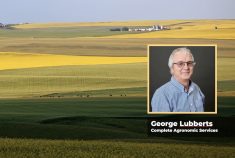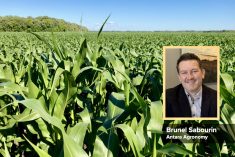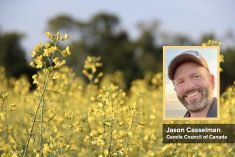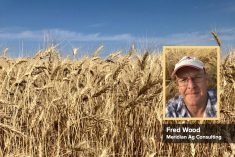The past two to three years have seen some encouraging signs of change for the better across Eastern Canada. Commodity prices are cyclically low yet corn, soybean and wheat yields have been trending upwards. There’s renewed interest in cover crops, and more growers have a renewed appreciation for soil health too, including a keener sense of accountability for farming’s impact on the environment.
Although the word that best describes cropping rotations is “stable,” there are those who believe the industry is in need of a refresher course where rotations are concerned. It’s not just corn, wheat and soybeans that are the focus, but traits and technologies, herbicides, fungicides — perhaps even types of tillage.
Read Also

Agronomists share tips for evaluating new crop products and tech: Pt. 3
With new products, new production practices and new technology converging on the agriculture industry at a frenetic pace in recent…
For Steve Johns, the message bears repeating: rotation, rotation, rotation!
“It all comes back to that diversity message, where we know rotating crops makes sense,” says Johns, agronomic sales representative with Syngenta Canada. “We know we get better corn yields after a crop of wheat, particularly if it’s had some red clover underseeded. We know all of this, and we know we should be rotating crops because it helps keep Mother Nature off balance.”
Most growers will concede that growing continuous soybeans is not a good idea, since the crop returns almost nothing to the soil and is a fertility “taker.” From Johns’ experience with agriculture and research, any time you keep growing the same crop and doing the same thing, management-wise, it’s a recipe for disappointment.
“Whether it’s root rots or weed spectrum or diseases or bugs, it just doesn’t make sense to do that,” he says. “Rotating crops and using different weed control programs is the best route. And I think we are getting there.”
The days of relying exclusively on glyphosate are over, yet that adjustment is still evolving among some growers. Others realize they need a more robust plan for managing different weed species with multiple modes of action. But that comes with reluctance, given glyphosate’s inexpensive price and its long-standing convenience. In the past 10 years, says Johns, the price of glyphosate has trended downward, and the default mindset says it’s an easy product to apply. The usage rate is flexible — a grower can double the rate without much concern for the crop — and it’s still effective on many weed species.
What’s needed now is a greater advocacy for rotations and multiple modes of action. Johns contends that industry stakeholders haven’t pushed as hard as they should have in the past, but a change is coming. The prevailing attitude of waiting until “all of the weeds” emerge before applying a single-pass herbicide is obsolete, as researchers and weed scientists have shown. The two-pass, multiple-mode herbicide program is now the standard in managing the proliferation of weed species.
“You can’t grow weeds and a crop… you can’t,” says Johns. “The resistance issue is one thing, but most farmers don’t want to take money out of their pocket as ‘resistance stewardship.’ And that’s partly human nature.”
That’s resulted in a change in Johns’ approach with some of his customers, where he has tried to convince more of them to use multiple modes of action and keep the crop clean. It not only maximizes yield potential, it also minimizes the potential for weed resistance.
“As an add-on it helps, but for guys to take $10 or $20 per acre out of their pocket, just to manage potential resistance that they haven’t seen on their farm yet, that’s a tough job,” he adds. “But if we can tell them that they’re getting an extra two or three bushels, then it makes sense.”
Don’t stop with herbicides
As hard as it is to get growers to rotate their herbicides and to keep fields clean, it shouldn’t be as difficult to convince them of the value of rotating fungicides. With most weed species, there’s only one generation during a growing season. But a disease pathogen can run through one generation in a matter of days or a week. In that case, it doesn’t make sense to use a single-site mode of action, particularly against foliar or blight diseases like northern corn leaf blight. Johns recalls one potato grower who applied Quadris the year it was launched in the late 1990s, and within one year, had resistance issues with that first-ever stobiluron on the market.
“We know that can happen and that it will happen,” he says. “If we pick a corn crop, we know we’re getting a good economic response to a fungicide at tassel, like a 10-, 15- or 20-bushel yield response. What’s a little disappointing is that we have companies that will sell single mode of action strobis and say, ‘That’s all you need’, whereas it really makes sense to have a fungicide that has two or even three modes of action.”
Johns states that most farmers don’t think about resistance in diseases in the same way they understand weeds, but then they’ve also been dealing with the latter for a longer period of time. And the use of glyphosate has transitioned from exclusive use to a tank-mix mindset, which has helped with herbicide resistance in many species. With diseases, the frequency of a new generation makes the use of single-site modes of action a liability.
The idea of simply rotating different classes of fungicides — a strobiluron one year and a triazole the following year — is a better approach, but Johns contends there’s one step that’s better still.
“It’s much better from a resistance management perspective to spray a strobi with the triazole this year, and a strobi and a triazole next year,” he says, noting it’s more challenging to get farmers to pencil out the benefits. “It’s more effective, long-term, to pile more effective modes of action on all at once than to rotate. If you just spray a strobiluron this year, you’ll start selecting for some resistant strains, then you go into next year, you may kill most of them. Then in year three when you go back in with a strobiluron again, you’ll have some resistant pathogens.”
It’s a numbers game, where the chances of a pathogen developing resistance to a single-site mode of action fungicide might be a million to one. Use both a strobiluron and a triazole together, the odds expand to a trillion to one. Add a third mode of action and that lengthens the odds even more.
Backdrop to long-term success
Part of the challenge in changing the mindset on rotating crops, technologies and chemistries is that much of it is repetition: farmers have “heard it all before.” Yet Wayne Black believes such repetition is necessary for driving the discussion on rotation and providing a foundation on which farmers, advisers and agronomists can plan for the long term. In the same way that farm management specialists talk of a five- and 10-year business plan, with details on loan payments and annual projections on costs and revenues, Black insists that farmers need to map out each field on their operation.
“The idea is to get growers thinking about where they want to be for their cropping, what’s their rotation going to be for the next two to three years to get to that stage, and what are the opportunities,” says Black, agronomy manager with Sunderland Co-operative.
Granted, that mindset goes beyond most three-crop rotations and more to crops grown under contract, like identity preservation (IP) soybeans or edible beans. Yet Black believes preparation is key in creating those opportunities and optimizing the full economic benefits. It’s one thing to tell farmers, “start with a clean field” or to rotate their chemistries and technologies. Those are important factors, but planning for success requires a longer-term vision, one that might extend beyond three years.

Black agrees that it’s a challenge to get farmers to look beyond a “farming for today” stop-gap mentality, especially with low commodity prices and tightening margins. But in managing only for weeds or diseases in 2017, most farmers don’t realize the impacts those weeds or pathogens will have in 2018, 2019 or 2020.
“Growers are complaining about their weed management costs, saying that herbicide is too expensive, but you’re not only concerned with the weeds during the growing season or at harvest,” says Black. “It’s the cost of the weeds that rob yield and will affect your cropping plans one, two or three years out.”
As for the cost of herbicide, Black insists farmers should be factoring costs beyond the price tag on the jug. Two applications of glyphosate will cost about $10 to $15 per acre per year, he says. But that same farmer should be using a herbicide program worth roughly $23 per acre per year to benefit from multiple modes of action. It’s not just the cost of the herbicide, it’s the value of the crop yield that’s lost by not managing weeds with a longer-term outlook.
“You can plan to manage things from a seed, trait or herbicide rotation perspective and start looking to the future,” says Black. Perhaps the field that’s planned for a particular crop for 2019 or 2020 isn’t weed-free today, but examining the weed spectrum in that field can point to what crop can be planted in three, four or five years. “Ask yourself, ‘Where do I want to go with my crop plans to get to that stage? And what are the opportunities that might come from a plan like that?’”
Planning also helps with the current debate over increasing employment costs, along with rising interest rates and continued low commodity prices.
“If you want to be farming 10 to 15 years from now, you need to be ready for higher employment costs and you need to be producing crops of a quality that qualifies for IP,” says Black. He notes that a rising minimum wage is a reality. “At the same time, you need to look at what you need to do to be profitable with higher hourly wages, because there are farmers out there who pay a much higher rate, and they’re still profitable.”
Managing for those margins, like managing production costs, is forcing a new focus on practices.
“That’s why you need that four- or five-year crop rotation plan for each field, and think about rotating your crops, rotating your herbicides and fungicides, and possibly your tillage,” says Black. “And be on the look-out for other opportunities. As you clean up your fields, as your soil health improves, improved yields will come naturally.”
















